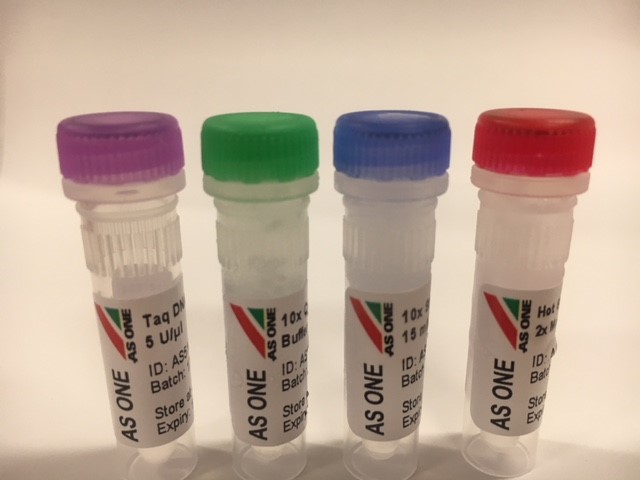Description
GC-rich Hot Start Taq 2x Master Mix II
| Cat. No. | Size Reactions | GC HS Taq 2x Master Mix II, 1.5 mM MgCl2 |
| AO332703 | 500 | 10 x 1.25 mL |
| AO332704 | 1,000 | 20 x 1.25 mL |
| AO332706 | 2,500 | 50 x 1.25 mL |
| AO332707 | 5,000 | 25 x 5 mL |
| AO332708 | 10,000 | 28 x 9 ml |
| AO332709 | 20,000 | 1 x 500 ml |
Store at -20°C. For in-vitro laboratory use only
Key Features
- For amplification of DNA targets with high GC content
- Convenient reaction set-up at room temperature
- High specificity, sensitivity and product yield
- Detection of low abundance targets
- Diminished formation of non-specific product
General Description
AS ONE GC-rich Hot Start Taq 2x Master Mix II is an all-in-one 2x master mix containing Hot Start DNA polymerase, GC Buffer II, dNTPs and MgCl2. Simply mix GC HS 2x Master Mix II with primers, template and water and you are ready to carry out successful primer extensions.
HS DNA Polymerase is a modified form of AS ONE Taq DNA polymerase, which is activated by heat treatment. A chemical moiety is attached to the enzyme at the active site, which renders the enzyme inactive at room temperature. Thus, during setup and the first ramp of thermal cycling, the enzyme is not active and misprimed primers are not extended. The result is higher specificity, increased sensitivity and greater yields when compared to standard DNA polymerases.
Master Mix II: Combination Buffer
Combination Buffer is a proprietary mixture of K+ and NH4+. This buffer combines high specificity with good product yield and high tolerance to optimization of primer annealing temperatures and Mg2+ concentrations due to its balanced ammonium-potassium formulation.
Composition of GC HS Taq 2x Master Mix II
0.2 units/µl HS DNA Polymerase
Tris-HCl pH 8.7, KCl, (NH4)2S04, 3 mM MgCl2, 1% Tween 20Ò.
0.4 mM of each dNTPs
Storage and Stability
The unopened kit is stable at -20°C for 2 year after the production date.
Quality Control
HS DNA Polymerase is tested for contaminating activities, with no traces of endonuclease activity, nicking activity, exonuclease activity or priming activity.
Unit Definition
One unit is defined as the amount of polymerase that incorporates 10 nmoles of dNTPs into acid-precipitable DNA in 30 minutes at 72°C under standard assay conditions.
Suggested Protocol
This protocol serves as a guideline only. Optimal reaction conditions may vary and must be individually determined.
- Set up reaction mixtures in an area separate from that used for DNA preparation or product analysis. Working on ice is not required.
- The final MgCl2 concentration of this 2x Master Mix is 1.5 mM. In some applications, more than 5 mM MgCl2 is required for best results. Use 25 mM MgCl2 to adjust the Mg2+ concentration according to table 1.
Table 1. Additional volume (mL) of MgCl2 per 50 mL reaction
| Final MgCl2 conc. in reaction (mM) | 1.5 | 2.0 | 2.5 | 3.0 | 3.5 | 4.0 | 4.5 |
| Volume of 25 mM MgCl2 | 0 | 1 | 2 | 3 | 4 | 5 | 6 |
- Thaw the Master Mix and primer solutions. It is important to thaw the solutions completely and mix thoroughly before use to avoid localized concentrations of salts.
- Prepare the reaction mix. Table 2 shows the reaction set up for a final volume of 50 m If desired, the reaction size may be scaled down. Use 10 ml of GC HSTaq 2x Master Mix I in a final volume of 20 ml.
Table 2. Reaction mix and template DNA
Component |
Vol./reaction* | Final Concentration* |
| 2x Master Mix | 25 µL | 1X |
| 25 mM MgCl2 | 0 µL (0-7 µL) | 1.5 mM (1.5-5 mM) |
| Primer A (10 μM) | 1 µL (0.5-5 µL) | 0.2 µM (0.1-1.0 µM) |
| Primer B (10 μM) | 1 µL (0.5-5 µL) | 0.2 µM (0.1-1.0 µM) |
| PCR-grade H2O | X µL | – – – – |
| Template DNA | X µL | Genomic DNA: 50 ng (10-500 ng)
Plasmid DNA: 0.5 ng (0.1-1 ng) Bacterial DNA: 5 ng (1-10 ng) |
| TOTAL volume | 50 µL | – – – – |
* Suggested starting conditions; theoretically used conditions in brackets
- Mix the master mix thoroughly and dispense appropriate volumes into reaction tubes. Mix gently, e.g., by pipetting the master mix up and down a few times.
- Add template DNA to the individual tubes containing the reaction mix.
- Program the thermal cycler according to the manufacturer’s instructions. For maximum yield and specificity, tempeatures and cycling times should be optimized for eacyh new template tafet or primer pair.
- Each program must start with an initial heat activation step at 95°C for 15 minutes.
Three-step PCR program
| Cycles | Duration of cycle | Temperature |
| 1 | 15 minutes a | 95°C |
| 25-35 | 20-30 secondsb
20-40 secondsc 30 secondsd |
95°C
55-60°Cd 72°C |
| 1 | 5 minutese | 72°C |
a For activation of the hot start enzyme
b Denaturation time may vary between thermocyclers. This step causes melting of the DNA template by disrupting the hydrogen bonds between complementary bases, yielding single-stranded DNA molecules.
c Annealing step allows primers to anneal to the single-stranded DNA template. Typically, the annealing temperature is about 3-5°C below the Tm of the primers used.
d Extension/elongation step – HS Taq has its optimum activity temperature at 72°C. At this step the DNA polymerase synthesizes a new DNA strand complementary to the DNA template strand. The extension time depends on the length of the DNA fragment to be amplified. As a rule of thumb, at its optimum temperature the DNA polymerase will polymerize a thousand bases per minute.



Reviews
There are no reviews yet.